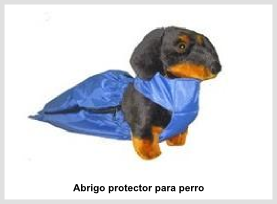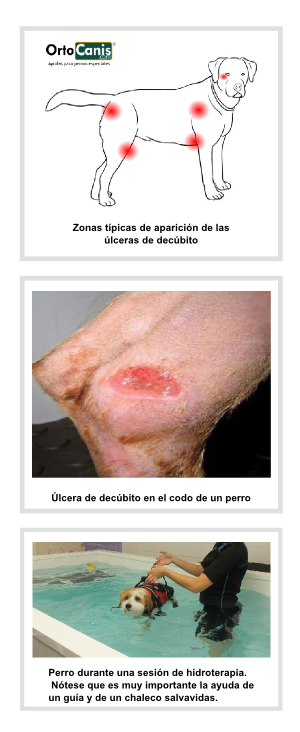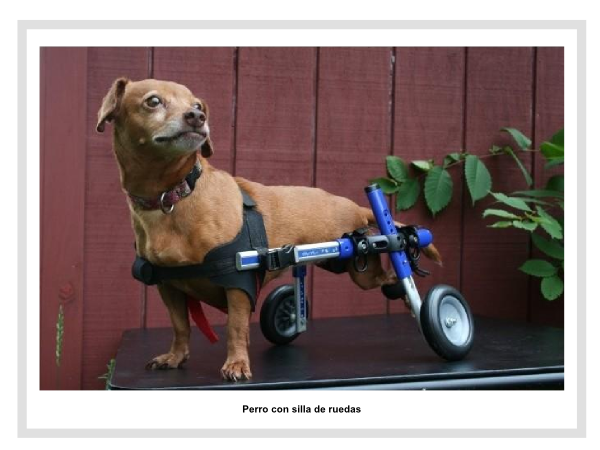When an animal suffers from a disease that prevents it from moving normally, it is not just necessary to take care of the affected body parts. You must also consider other elements that affect the animal as a whole and interfere with its quality of life and recovery.
1. HYGIENE
You must keep the animal’s skin away from faeces and/or urine. You can wash the animal with physiological saline solution or special wipes for dogs. Baby wipes can cause irritation as the pH of human skin and animal skin is different.
2. DIET
Pathological states cause nutritional imbalances. A good diet is KEY to the animal’s recovery. You should take advice from the vet about the best diet for the dog. Bear in mind that a lot of the time there are illnesses other than paralysis and the animal should be fed accordingly. For example, kidney problems are very common in older animals. A large part of the treatment is based on a specific diet (that is low in protein and phosphorous) which is essential when trying to slow down the aforementioned illness. It is also very likely that the vet will want to combine two types of diet or add a supplement in order to tackle both illnesses.
3. DECUBITUS ULCERS
Decubitus ulcers tend to form on the areas of the body that protrude the most, such as the elbows, ankles, hips and the periocular bone. They are caused by the constant pressure on these areas and the nutritional deficiencies caused by serious illnesses. To prevent them it is essential to change the animal’s position every few hours and use passive physiotherapy techniques (i.e. the owner should move the animal’s limbs.) We can help to heal the wounds by applying healing ointments or moisturizers such as centella asiatica and aloe vera.
4. PROTECT THE SKIN
Diapers exist that are specially designed for dogs. Not only are they absorbent, they also help to prevent the urine and faeces from irritating the skin and avoid accidents on the floor or the carpets. It is very important to check the nappy frequently and change it whenever necessary. You must be particularly cautious when the dog is in an outdoor environment, since there is a possibility that flies can lay eggs on dirty parts of its skin. Since the dog has mobility problems, it will not be able to chase them away. Whenever the animal needs to go outdoors, take its nappy off so that its skin can “breathe” and the humidity does not cause ulcers. You can also use pads on top of its bed.
5. AVOID DRAGGING THE DOG
This is the most common way that wounds appear. They are difficult to get rid of because the animal will always tend to put pressure on them. That’s why you should avoid them appearing. There are drag coats available that prevent the animal from having contact with the floor.
6. LOOK AFTER THE SKIN
If frequent baths are necessary, we recommend that you use shampoos that are specially formulated for allergic dogs, since they do not destroy the protective barrier of lipids and can be used several times a week. You can also help to improve the animal’s skin by giving it supplements to strengthen it, like omega-3 fatty acids and some vitamins. Consult your vet, as there are many formulas available.
7. MONITOR THE BLADDER
 Lots of dogs that suffer from paralysis have problems urinating. Some of them are unable to hold the urine and it drips out, others are unable to empty the bladder and the owner has to do it for them, around 3 times a day. Good hygiene when urinating will help to prevent urine infections, which are frequent in these cases. It is also important to be very observant so you detect changes in the smell and/or colour of the urine, which could signify a problem.
Lots of dogs that suffer from paralysis have problems urinating. Some of them are unable to hold the urine and it drips out, others are unable to empty the bladder and the owner has to do it for them, around 3 times a day. Good hygiene when urinating will help to prevent urine infections, which are frequent in these cases. It is also important to be very observant so you detect changes in the smell and/or colour of the urine, which could signify a problem.
8. WHEELCHAIRS
If the animal still has strength in its front legs, using a dog wheelchair can be very beneficial: you can avoid decubitus ulcers to a great extent, strengthen the animal’s body, help it to build muscle mass and above all, promote its mental wellbeing, offering it the independence that dogs crave so much. We recommend that you consult the vet about the suitability of wheelchair use in each individual case.
9. PHYSICAL THERAPY
Massage your dog. Massages increase blood circulation, help to reduce pain and strengthen the bond with the owner. Move the limbs gently, without exerting force. This way, you will avoid the joints becoming stiff due to immobility. Click here for more information. Whenever possible, you can use a front, rear or full harness to help the animal to walk and allow it a degree of active movement. Professionals can come to your home to apply physiotherapy techniques, and there are also veterinary clinics in Spain where these techniques are applied. In a lot of cases, hydrotherapy is an interesting option, as it allows the animal to move without having to support its weight. Using a lifejacket is essential when doing this.
10. GO FOR A WALK!
Whenever possible take the dog for a walk outside, even if you need to use special harnesses, wheelchairs, trolley walkers or strollers. A dog’s sense of smell is a fundamental part of its personality. They need to smell varied environments and other animals to be in good mental health. Paralysis is not an excuse to deprive a dog of this: you will see that emotionally, there will be a notable change which will obviously be reflected in the dog’s physical health.



